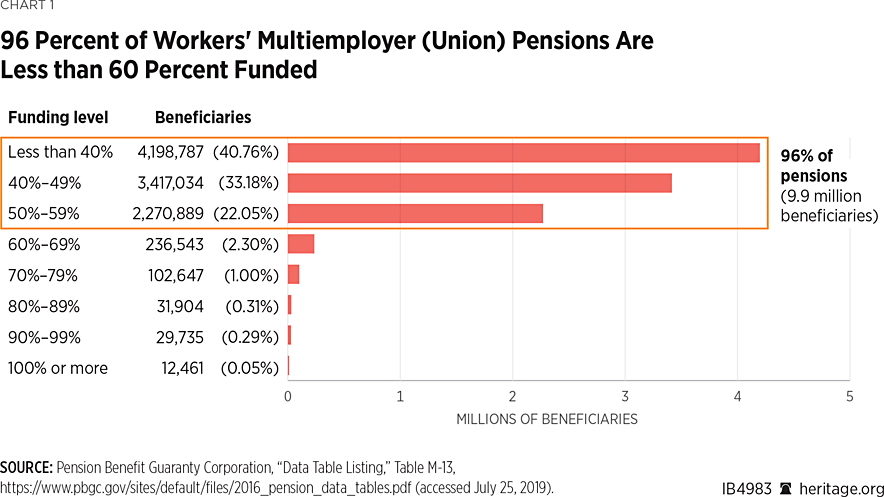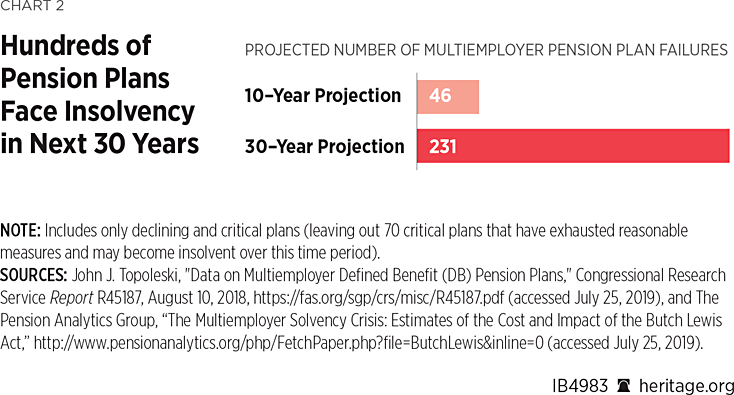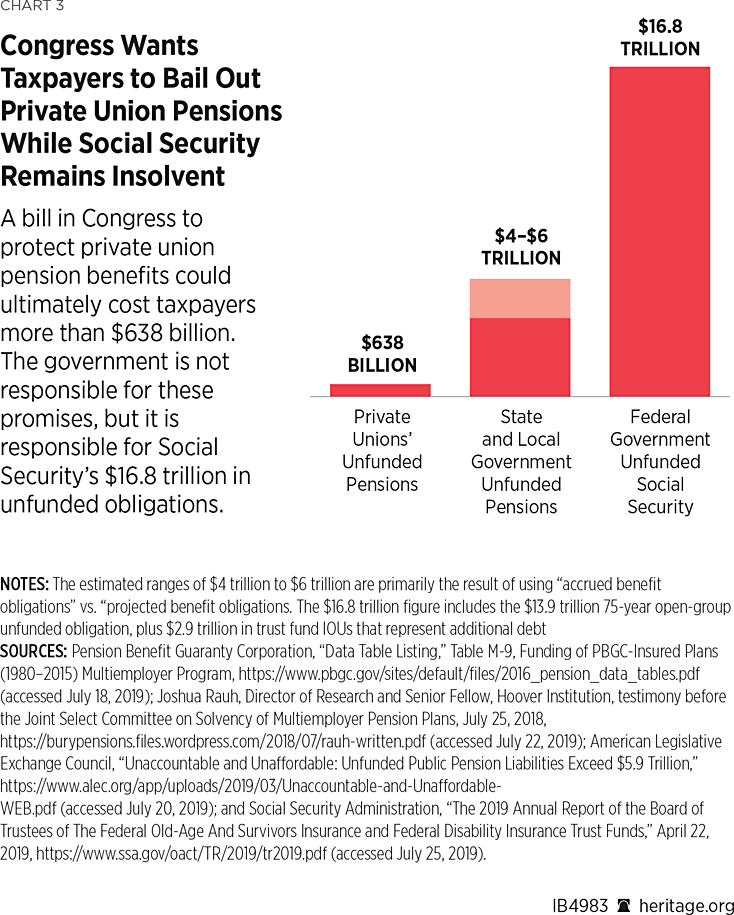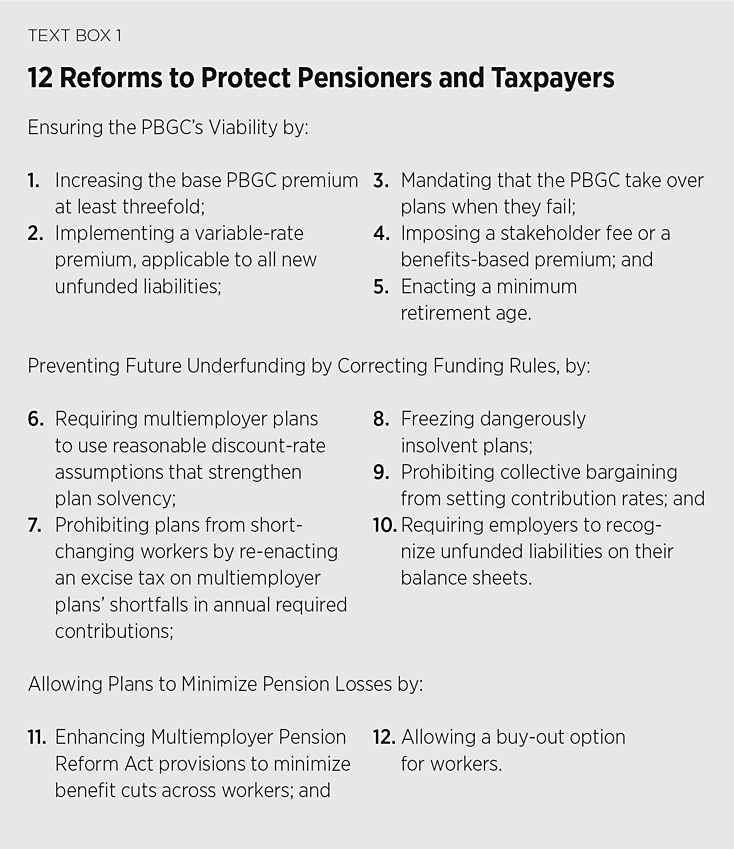The House of Representatives just passed a bill intended to “rehabilitate” multiemployer, or union, pension plans. This Issue Brief describes the nature of the multiemployer pension crisis, what the Rehabilitation for Multiemployer Pensions Act of 2019 (H.R. 397) would accomplish, and which alternative measures would provide a more responsible and fair solution.
The Multiemployer Pension Crisis
There are about 1,400 multiemployer pension plans across the U.S.,REF representing about 10.6 million workers and retirees.REF These plans have overpromised and underfunded pension benefits, leaving 96 percent of workers with multiemployer pensions in plans that are less than 60 percent funded.REF (See Chart 1.) The Pension Benefit Guaranty Corporation (PBGC) estimates that multiemployer pension plans have promised a combined total of $638 billion more in pension benefits than they will be able to pay.REF

To date, more than 50 multiemployer pension plans have become insolvent and are currently receiving PBGC assistance. Another 46 are projected to fail within the next 10 years,REF and a total of 231 are projected to fail within 30 years.REF Absent reform, many more will likely fail outside the 30-year window.
The multiemployer pension funding crisis is pervasive and growing by the day as an estimated 83 percent of plans continue to dig themselves deeper into debt each year.REF Under appropriate discount-rate assumptions, even the supposedly well-funded plans would need to double or triple their contributions to meet their promises.REF
Considering the breadth and depth of the multiemployer pension crisis, it would be unwise and unfair for Congress to pledge taxpayer support for private-sector pension plans. Doing so would be extremely expensive and set the stage for a bailout of state and local pension plans with an estimated $4 trillionREF to $6 trillionREF in unfunded pension liabilities.

What Would H.R. 397 Do?
The House of Representatives voted this week on H.R. 397, the Rehabilitation for Multiemployer Pensions Act of 2019. This act is a bailout without reform. It provides two separate layers of taxpayer-funded bailouts, but does nothing to reduce or even contain the underfunding problem—instead, it would make it worse. Consequently, plans could continue overpromising and underfunding benefits, leaving taxpayers on the hook for even more than the existing $638 billion in unfunded union pension promises.REF H.R. 397 consists essentially of two parts:
Part 1: Loans. The act would establish a Pension Rehabilitation Administration that would use taxpayer dollars to make loans to multiemployer plans that are either “insolvent” or “critical and declining.” The loans would be massively subsidized, interest-only, balloon-payment loans that could be forgiven if plans cannot repay them.
Part 2. Direct Cash Assistance. Recognizing that effectively bankrupt pension plans could never repay loans, the act would give plans direct taxpayer funds—as much as tens of billions of dollars to a single plan—to increase the plans’ chances of being able to repay the loans. These funds would come through the PBGC, which is currently not a taxpayer-financed entity, but would become taxpayer-funded through the Rehabilitation for Multiemployer Pensions Act.
The Fallacy of a Loan Arbitrage
The idea for the cash assistance and loans is that plans will be able to use the loans to purchase more secure assets to guarantee their participants’ promised benefits, and then leverage the direct taxpayer funds in the stock market to earn high returns and pay back the loan. If this were a sound strategy, the federal government should issue $10 trillion in debt and invest it in the stock market in hopes of paying off the national debt over 30 years.
Investing taxpayer funds is not an appropriate role for government, which should extract no more in taxes than necessary for core government functions, and leave individuals to make their own investment choices. Moreover, H.R. 397 is a risky strategy. Puerto Rico tried this loan arbitrage strategy in 2008 by issuing pension bonds and investing the proceeds. When the stock market fell by about 50 percent over the next year, the pension fund and the commonwealth’s overall finances were deeper in debt.
The nonpartisan Pension Analytics Group concluded that this loan concept “would delay a weak plan’s insolvency, but would not prevent it. Eventually, taxpayers and the PBGC will be called upon to deal with insolvency costs in the form of loan defaults and PBGC assistance payments.”REF
Plans Unlikely to Repay Loans
The loan qualification standard under the Rehabilitation for Multiemployer Pensions Act is equivalent to requiring mortgage applicants to prove they have no job, no savings, and a declining capacity to find employment before they can qualify for a mortgage. Considering that such loan qualifications are the exact opposite of what is necessary to receive a loan in the private market, it would be highly unlikely that plans could repay the loans. The United Mine Workers of America’s (UMWA’s) plan, for example, has 27 retirees for every active worker, is closed to new participants, and will be insolvent in three years.REF How could plans like the UMWA’s pay full benefits and repay a government loan? They could not—which is precisely why the Rehabilitation for Multiemployer Pensions Act would also give them direct cash and allows loan forgiveness.
What Would H.R. 397 Cost?
The Congressional Budget Office (CBO) estimated that the Rehabilitation for Multiemployer Pensions Act would create $67.7 billion in new costs over the first 10 years, offset by some unrelated and recycled pay-fors, such as modifying the distribution rules for beneficiaries of IRAs, that would generate $19.2 billion in revenues, for a 10-year net score of $48.5 billion. This cost estimate is understated for multiple reasons, including the fact that it is only a 10-year estimate and loans would not come due until year 30, the CBO noted uncertainty in predicting which loans would be forgiven, and the projection includes a limitation in the bill so that only plans already insolvent and “critical and declining” at the time of enactment would qualify for assistance.
In reality, if Congress does not want to pick winners and losers among union pension plans, it will later have to extend the provisions to multiemployer pension plans that become insolvent after enactment of the bill. In the end, the true cost of this proposal could exceed the existing $638 billion in unfunded multiemployer pension obligations.REF
If taxpayers are going to give private union pension plans direct money, give them loans to invest in the stock market, potentially forgive those loans, and allow the plans to keep promising more than they set aside to pay, would it not be a better solution to directly bail out all $638 billion in unfunded promises and close the plans for good?
Bailouts Without Reform Are Reckless and Irresponsible
There are clear reasons why multiemployer pension plans are underfunded and, in general, those reasons boil down to self-interested and reckless management, with trustees choosing to assume high rates of return that allow them to contribute only a fraction of what they should in order to make good on their promises. While bailing out multiemployer pension plans would protect millions of workers from pension losses, it would also reward unions and employers who failed to make good on their promises.
Without reform to the rules that govern multiemployer pension plans, and without penalties on those who knowingly promised more than they set aside to pay, bailouts will only exacerbate pension underfunding. The Rehabilitation for Multiemployer Pensions Act would allow plans to continue to make promises they cannot keep, putting taxpayers on the hook for potentially ever-increasing liabilities.
Bailouts Pick Winners and Losers
Bailouts also mean that the government gets to pick which workers’ retirement plans are protected and which ones are left to go insolvent. The intentionally restricted version of the Rehabilitation for Multiemployer Pensions Act (limiting assistance to plans already insolvent as of the time of enactment, so as to reduce the apparent cost of the bill) would protect upwards of 1.3 million multiemployer pension beneficiaries. The remaining roughly 9.3 million would either have to quickly change their assumptions to qualify for a bailout, or else wait for Congress to extend the act’s provisions to other insolvent plans down the road (as Congress has already done multiple times in its bailout of a select group of retired coal miners’ health benefits). Later, Congress would have to decide which, if any, of the 27.5 million workers with non-union private pension plans it bails out, as well as which of the tens of millions of workers and retirees with state and local pension plans it bails out.
If Congress does not want to pick winners and losers, it should not open the door to any form of pension bailouts. And before Congress addresses the private multiemployer pension crisis, it should fix its own $16.8 trillion unfunded pension crisis that is Social Security.REF

How Congress Can Responsibly Resolve the Multiemployer Pension Crisis
If Congress wants to protect workers, retirees, and taxpayers, lawmakers should ensure the PBGC’s viability as an insurance backstop, change the rules to prevent this situation from continuing to get worse, and enact measures to help plans minimize pension losses.

Ensuring the PBGC’s Viability. While the federal government has not made pension promises itself, and while the PBGC is not a taxpayer-financed entity, Congress has nevertheless failed to appropriately manage the PBGC’s multiemployer program to preserve its solvency. Thus, lawmakers should:
- Increase the base PBGC premium at least threefold. Multiemployer plans pay only $29 per year, compared to up to $621 per year for single-employer plans.REF
- Implement a variable-rate premium, applicable to all new unfunded liabilities. Both the Obama and Trump Administrations proposed variable-rate rate premiums that would require underfunded plans to pay higher premiums than plans that make adequate contributions.
- Mandate that the PBGC take over plans when they fail. When a multiemployer plan becomes insolvent, the PBGC should terminate the plans and stop paying the plan trustees’ salaries, just as it does for single-employer plans.
- Impose a stakeholder fee. An $8-per-month fee, assessed on employers, unions, and workers and retirees, would generate about $3 billion per year and keep the PBGC solvent for at least 20 years.
- Impose a benefits-based premium. Alternatively, a 10 percent premium on all multiemployer pension benefits would generate $4.5 billion per year and keep the PBGC solvent until 2056.REF
- Enact a minimum retirement age. Plans pay the same PBGC rates, but some can receive PBGC benefits as early as age 55 while others may be 65 or older. Everyone should be eligible at the same age.
Preventing Future Underfunding by Correcting Funding Rules. Reforms to multiemployer pension plans are necessary to protect workers from irresponsible multiemployer pension funding rules that effectively allow unions and employers to steal from workers a portion of their compensation. Policymakers should:
- Require multiemployer plans to use reasonable discount-rate assumptions that strengthen plan solvency. This is perhaps the single-most important reform to the multiemployer pension system. There is no justifiable reason to allow multiemployer plans to use whatever discount rates they deem reasonable while requiring single-employer plans to abide by a prescribed set of drastically lower rates. Allowing this discretion effectively makes guaranteed benefits discretionary benefits—dependent on the plan’s investments instead of workers’ years of service.
- Prohibit plans from shortchanging workers by re-enacting an excise tax on multiemployer plans’ shortfalls in annual required contributions. Such a tax, which effectively forces plans to make their required contributions, already applies to single-employer pensions, but multiemployer plans can avoid it if they say they cannot meet their required contributions.
- Freeze dangerously insolvent plans. If plans are extremely underfunded, they should not be allowed to make new promises.
- Prohibit collective bargaining from setting contribution rates. Negotiating for both pension accrual rates and pension contribution rates is like setting the price of an item without regard to how much it costs to produce the item. Contributions should be established by math—not negotiations.
- Require employers to recognize unfunded liabilities on their balance sheets. Unless and until someone is ultimately on the hook for unfunded union pension promises, there will be no incentive to reduce them.
Allowing Plans to Minimize Pension Losses. Some plans are so underfunded that increasing employer contributions alone would not be viable. These plans need other options in order to confront their unfunded promises and minimize benefit cuts across workers and retirees. Policymakers should:
- Enhance Multiemployer Pension Reform Act provisions to minimize benefit cuts across workers. To help protect younger workers and retirees, Congress should ease the requirements to qualify for the act’s reductions to instead only require that reductions improve plan solvency.
- Allow a buy-out option for workers. Many workers’ pension contributions are funding current retirees’ benefits and their plans will be insolvent by the time they retire. Workers should have the option to receive a retirement benefit they own.
Conclusion
Rewarding union and employer trustees who mismanaged plans by using taxpayer dollars to cover 100 percent of their broken promises is no way to solve the pervasive multiemployer pension crisis. This proposal does absolutely nothing to require plans to fund the benefits they promise in the future, nothing to hold employers and unions responsible for their broken promises, and nothing to reduce the massive shortfall in unfunded pensions. Instead, it encourages plans to continue overpromising and underfunding on the taxpayer dime, and gives plans tens of billions of dollars to invest in the stock market in hopes of high returns. This makes the problem worse, not better, but somehow, with taxpayers picking up the tab, it is sold as a solution.
There is an actual solution that includes Congress: protecting pensioners by ensuring that its own entity—the PBGC—can provide benefits when plans fail; changing the rules governing multiemployer plans to prohibit the current practice of overpromising and underfunding (which is equivalent to wage theft), and allowing plans to reduce benefits in ways that minimize pension losses across current and retired workers. These changes would protect workers and retirees without forcing taxpayers to pay for private union pensions’ broken promises, and without setting a precedent for federal bailouts of non-union private pensions and state and local pensions.
Rachel Greszler is a Research Fellow in Economics, Budget, and Entitlements in the Grover M. Hermann Center for the Federal Budget, of the Institute for Economic Freedom, at The Heritage Foundation.



